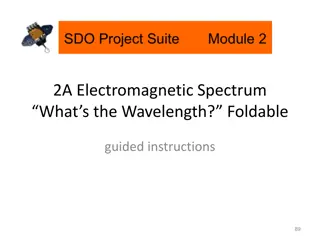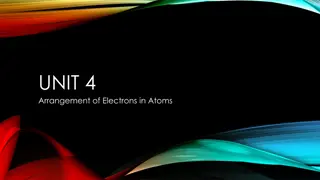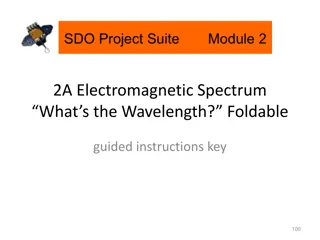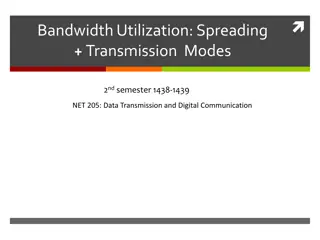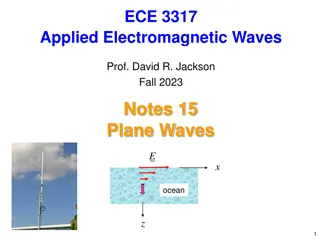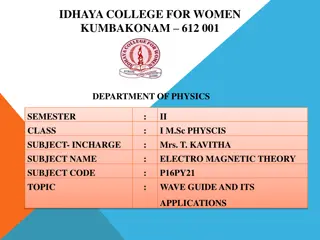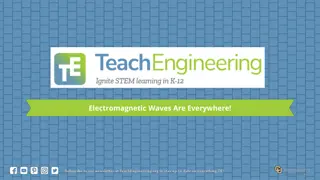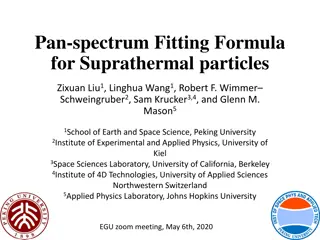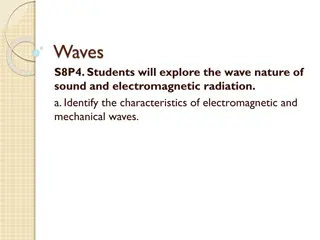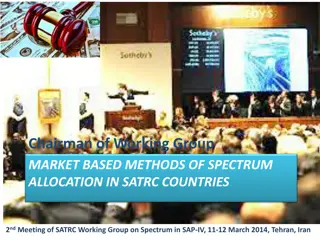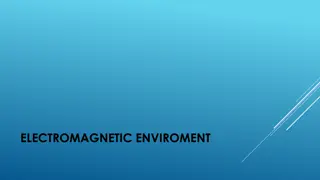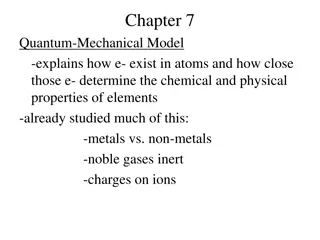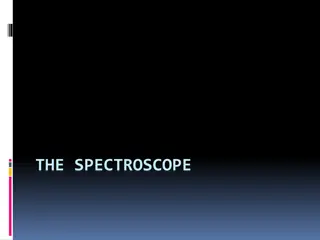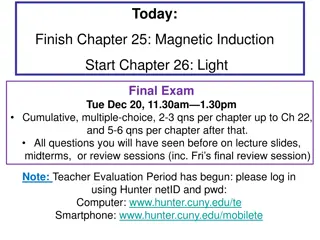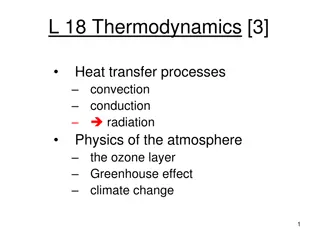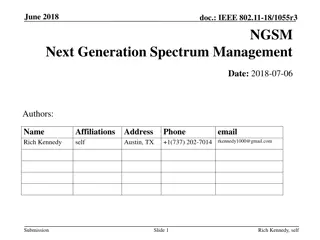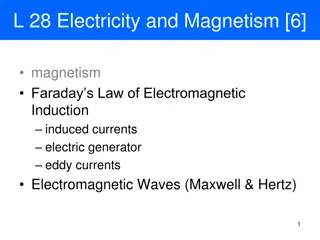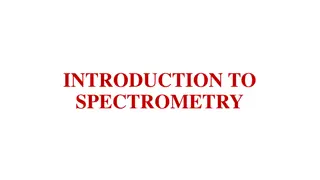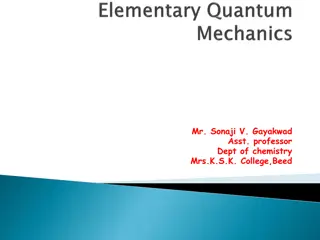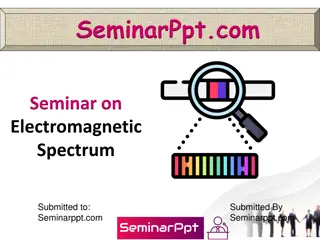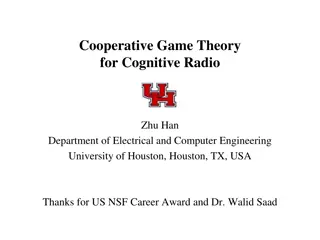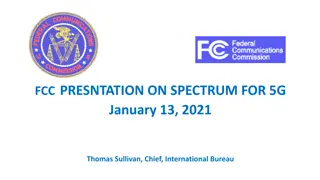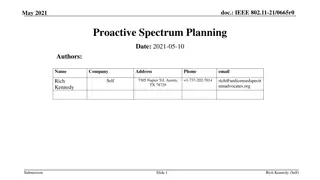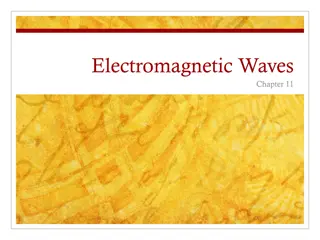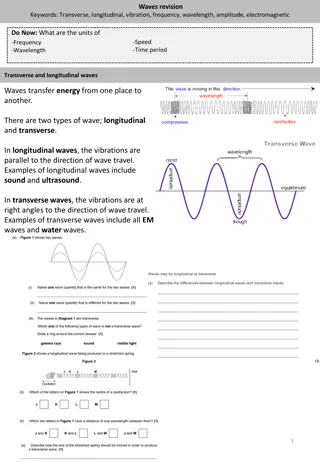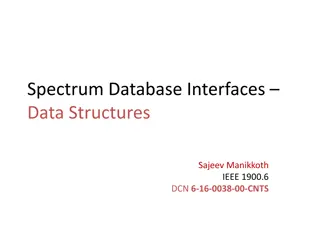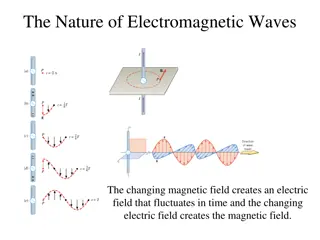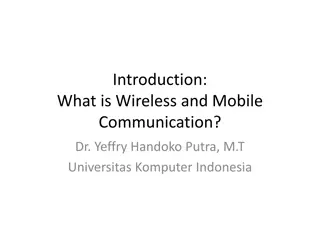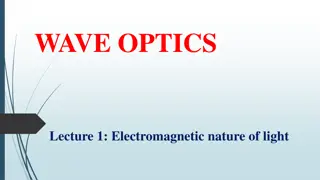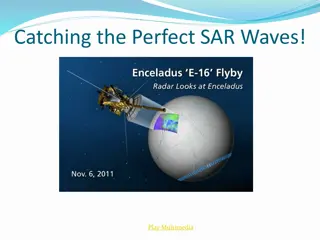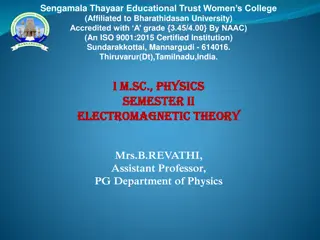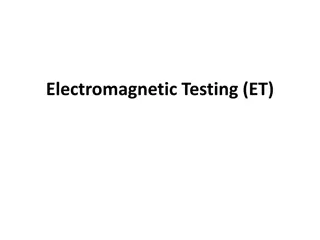Understanding Electromagnetic Waves: Maxwell's Contributions and Hertz's Observations
James Clerk Maxwell's groundbreaking work in the 19th century revealed the fundamental nature of light as an electromagnetic wave. His equations formed the basis for understanding the interplay between electricity and magnetism, predicting the existence of electromagnetic waves. Heinrich Hertz furth
4 views • 24 slides
Electromagnetic Surveying Methods and Applications
Electromagnetic surveying, conducted by Dr. Laurent Marescot, utilizes various methods like resistivity, induced polarization, and high-frequency techniques for exploration and investigation purposes. The electromagnetic method involves generating primary fields and detecting secondary fields to ana
2 views • 55 slides
Understanding Electromagnetic Spectrum Wavelengths: A Foldable Guide
Explore the Electromagnetic Spectrum through a foldable activity that involves identifying wavelengths, comparing sizes, learning about frequency, and examples of EM waves. Discover radio waves, microwaves, infrared rays, and visible light wavelengths in an interactive way.
0 views • 11 slides
Understanding Electromagnetic Radiation and its Properties
This educational content delves into the arrangement of electrons in atoms, focusing on the properties of light and the electromagnetic spectrum, including the visible light spectrum. It explains wavelike behavior, wavelength, frequency, and their mathematical relationship, providing practice questi
0 views • 39 slides
Exploring the Electromagnetic Spectrum with Wavelengths Foldable
Explore the Electromagnetic Spectrum through a guided foldable activity that involves researching and labeling different wavelengths, comparing sizes, identifying longest and shortest waves, understanding frequencies, and providing examples of wavelengths from various sources such as radio broadcast
0 views • 13 slides
Spectrum Sensing for Enhanced Channel Access in Wireless Networks
This document presents a proposal for Spectrum Sensing Based Deferral (SSBD) to improve channel access in wireless networks. SSBD incorporates spectrum sensing with transmission deferral in a time-bound manner to enhance performance, reliability, and latency control. The proposed solution safeguards
1 views • 11 slides
Understanding Spread Spectrum Techniques in Data Transmission
Explore the concepts of bandwidth utilization, spreading, and transmission modes in data transmission and digital communication. Learn about spread spectrum techniques such as frequency hopping and direct sequence spread spectrum, which enable efficient sharing of wireless communication channels. Di
1 views • 28 slides
Understanding Spread Spectrum Communication Systems
Spread spectrum techniques involve spreading a signal over a wide bandwidth for various reasons, such as secure communication, resistance to interference, noise, and jamming. This summary introduces Direct Sequence Spread Spectrum (DSSS), Frequency Hopping Spread Spectrum (FHSS), Time Hopping, and h
0 views • 25 slides
Understanding Waves: A Visual Exploration
Explore the fascinating world of waves through visually engaging images and interactive clickers. Learn about different types of waves, including longitudinal and transverse waves, and discover what waves carry - energy, not matter. Delve into the concepts of mechanical and electromagnetic waves, an
1 views • 37 slides
Understanding UV/Visible Spectroscopy and Electromagnetic Radiation
Spectroscopy is the study of the interaction of matter with light, specifically UV and visible radiation. Electromagnetic radiation, consisting of photons, transmits energy through space as waves with oscillating electric and magnetic fields. The relationship between wavelength and frequency is key,
0 views • 50 slides
Understanding Electromagnetic Waves: A Comprehensive Overview
Introduction to plane waves, the electromagnetic spectrum, TV and radio spectrum, and a comparison of wired and wireless systems. Discusses the properties and applications of various frequency ranges within the electromagnetic spectrum. Highlights the efficiency of wireless systems over wired system
0 views • 37 slides
Understanding Waveguides in Electromagnetic Theory
The concept of waveguides in electromagnetic theory involves the transmission of electromagnetic waves through hollow metallic tubes, such as rectangular and circular waveguides made from materials like copper and aluminum. These waveguides support different modes of propagation, including TE, TM, a
5 views • 15 slides
Unveiling the World of Electromagnetic Waves
Delve into the omnipresence of electromagnetic radiation with engaging activities that explore the characteristics of the electromagnetic spectrum, devices utilizing electromagnetic waves, and the mechanisms behind their functionality. Enhance your understanding by partaking in interactive learning
0 views • 7 slides
Understanding the Wave Theory of Light and Electromagnetic Spectrum
Explore the fascinating world of electromagnetic waves, visible light, and the wave theory through concepts such as wavelength, frequency, amplitude, and the speed of light. Understand how these elements are interconnected, and discover the diverse range of the electromagnetic spectrum. Dive into th
0 views • 77 slides
ICAO Handbook on Radio Frequency Spectrum Requirements for Civil Aviation Workshops
This handbook provides insights into spectrum requirements for civil aviation workshops conducted in Egypt and Thailand in October 2016. It covers spectrum strategy, frequency management, spectrum overview for aviation, and frequency assignment planning to support the application of SARPs in Annex 1
0 views • 10 slides
Unified Pan-Spectrum Fitting Formula for Suprathermal Particles
Unifying spectrum formulas for suprathermal particles, the proposed pan-spectrum formula provides a versatile fitting method encompassing classic double-power-law, band function, and kappa distribution. Motivated by the need for more accurate spectrum information, the formula introduces five paramet
0 views • 14 slides
Understanding Waves: Characteristics and Types Explained
Explore the wave nature of sound and electromagnetic radiation, distinguishing between electromagnetic and mechanical waves. Waves are energy-carrying disturbances that do not transport matter. Mechanical waves require a medium for energy transfer, while electromagnetic waves can travel through spac
0 views • 26 slides
Market-Based Spectrum Allocation Strategies in SATRC Countries
Explore the implementation of market-based methods for spectrum allocation in SATRC countries. Learn about the requirements, benefits, and challenges associated with adopting market-based mechanisms, especially in the context of increasing demand for spectrum and technological advancements. Discover
0 views • 41 slides
Understanding Harmonics in Electromagnetic Environments
In the realm of electromagnetic environments, the generation of electromagnetic interference (EMI) through harmonics plays a crucial role. This article delves into the concept of harmonics, their generation in simple DC power supplies, and the impact they have on electronic devices. From the basics
0 views • 31 slides
Understanding Quantum-Mechanical Model and Electromagnetic Waves
Quantum-Mechanical Model delves into how electrons exist in atoms, shaping the chemical and physical properties of elements. It contrasts metals and non-metals, emphasizes noble gases' inertness, and explains the charges on ions. Additionally, it explores the similarities between electrons and light
0 views • 33 slides
Exploring the World of Spectroscopy and the Electromagnetic Spectrum
Spectroscopy is a crucial tool for astronomers to analyze the composition of objects in space by separating light into its constituent colors. Each chemical element has a unique spectral fingerprint that helps in identification. The Electromagnetic Spectrum provides a comprehensive view of different
0 views • 15 slides
Understanding Electromagnetic Waves and Their Velocity
Light, as a transverse wave, is a part of the electromagnetic spectrum produced by accelerating electrons. Electromagnetic waves originate from vibrating charges, creating a continuous cycle of electric and magnetic fields. The velocity of electromagnetic waves is constant due to energy conservation
0 views • 32 slides
Understanding Thermal Radiation and the Electromagnetic Spectrum
Thermodynamics governs heat transfer processes like convection, conduction, and radiation, which play vital roles in the physics of the atmosphere and climate change. This content explores the concept of thermal radiation, the electromagnetic spectrum, emission, absorption, and how objects radiate t
0 views • 25 slides
Next Generation Spectrum Management Initiative Overview
Rich Kennedy presented on the need to change spectrum management practices within IEEE 802, addressing the results of straw polls conducted and proposing further investigation into Multi-band White Space feasibility. The presentation also highlighted the interest in advocating for an AI-managed spec
0 views • 14 slides
Understanding Magnetism: Faraday's Law and Electromagnetic Induction
Explore the fascinating world of magnetism and electromagnetism with insights into Faraday's Law of Electromagnetic Induction, induced currents, and the basic principles of magnetism. Discover how a changing magnetic field can produce a current and unravel the key concepts behind electromagnetic wav
0 views • 24 slides
Understanding Spectrometry and Electromagnetic Waves
Spectrometry plays a vital role in analytical chemistry by studying the interactions of radiation and matter through electromagnetic waves. These waves, characterized by varying electric and magnetic fields, travel at the speed of light in vacuum with a constant velocity. The properties and characte
0 views • 24 slides
Understanding Black Body Radiation: Key Concepts and Applications
Black body radiation is a fundamental concept in physics, with theoretical black bodies absorbing all radiation. While no material is a perfect black body, carbon comes close. This radiation curve demonstrates energy emission at different wavelengths, influenced by temperature variations. Stars serv
0 views • 13 slides
Understanding the Electromagnetic Spectrum: A Comprehensive Overview
The electromagnetic spectrum encompasses a vast range of frequencies and wavelengths of electromagnetic radiation. This seminar presentation delves into the definition, uses, significance, and formulas associated with the electromagnetic spectrum. Covering topics from radio waves to cosmic rays, it
0 views • 20 slides
Cognitive Radio Network and Game Theory Exploration at University of Houston
Explore the application of cooperative game theory in cognitive radio networks, focusing on spectrum sensing, dynamic spectrum access, and coalitional games. Detailed overview of research conducted at the Department of Electrical and Computer Engineering, University of Houston. Learn about cognitive
0 views • 42 slides
The Future of 5G: FCC's Spectrum Plans and Innovations
The FCC's presentation highlighted the importance of spectrum for 5G development, emphasizing the key components of their 5G FAST Plan. The plan focuses on pushing more spectrum into the market, updating infrastructure policy, and modernizing regulations to drive innovation and investment in the U.S
0 views • 12 slides
IEEE 802 Spectrum Planning: Proactive Approach for Improved Spectrum Management
Exploring the need for proactive spectrum planning in IEEE 802 to better manage the complex process of meeting spectrum needs efficiently and effectively. Delving into the challenges of spectrum allocation, sharing, and optimization to ensure that standards have the RF spectrum necessary for their r
0 views • 9 slides
Understanding Electromagnetic Waves: Essential Concepts and Applications
Electromagnetic waves are a fundamental aspect of physics, characterized by the transmission of energy through vibrating electric and magnetic fields. This comprehensive guide explores the production, properties, and applications of electromagnetic waves, shedding light on topics such as photon beha
0 views • 21 slides
Understanding Waves: Types, Equations, Reflection, and Electromagnetic Spectrum
Waves are vital in transferring energy, and they come in two main types: longitudinal and transverse. Learn about wave properties, equations relating to frequency, time period, and wave speed, as well as reflections, refractions, and the electromagnetic spectrum. Discover how different types of wave
0 views • 4 slides
Understanding Spectrum Databases and PAWS Parameters
Explore the world of Spectrum Databases and PAWS parameters, which provide essential information about available spectrum, permissible power levels, regulatory domains, geolocation data, and more. Learn about typical deployments, data types, and spectrum scheduling to enhance your understanding of s
0 views • 16 slides
Understanding Electromagnetic Waves: Speed, Spectrum, and Applications
Electromagnetic waves are characterized by the interplay between changing magnetic and electric fields, propagating at the speed of light in a vacuum. This speed, denoted by 'c,' is a fundamental constant. The electromagnetic spectrum encompasses a range of frequencies and applications, from radio a
0 views • 12 slides
Understanding Wireless and Mobile Communication Fundamentals
Explore the basics of wireless and mobile communication, covering topics such as transmitting voice and data through electromagnetic waves, the electromagnetic spectrum, wavelength of different technologies, frequency channels, and examples of channel allocation between stations. Learn about simplex
0 views • 42 slides
Understanding the Electromagnetic Nature of Light in Wave Optics
Exploring the electromagnetic properties of light, this lecture covers the dual nature of light as both a wave and particles, the quantized particle nature of light known as photons, and the manifestation of the electromagnetic nature of light through Maxwell's equations. It delves into wavefronts,
0 views • 8 slides
Understanding Electromagnetic Waves and Radar Systems
Dive into the world of electromagnetic waves and radar systems with detailed explanations on wave basics, the electromagnetic spectrum, radar technology, and applications in geometry. Discover how radio waves are used in radar systems and the importance of electromagnetic energy in modern engineerin
0 views • 13 slides
Understanding Electromagnetic Waves in Physics
Exploring the propagation of electromagnetic waves in different mediums such as free space and isotropic dielectrics. Discusses Maxwell's equations, wave equations, transverse nature, energy transmission, and impedance in electromagnetic wave propagation.
0 views • 24 slides
Understanding Electromagnetic Testing (ET) in NDT
Electromagnetic Testing (ET) is a crucial NDT method involving techniques like Eddy Current Testing (ECT) and Alternating Current Field Measurement (ACFM). It is used for crack detection, material thickness measurement, and more in various industries due to its sensitivity and immediate results. Des
0 views • 21 slides


